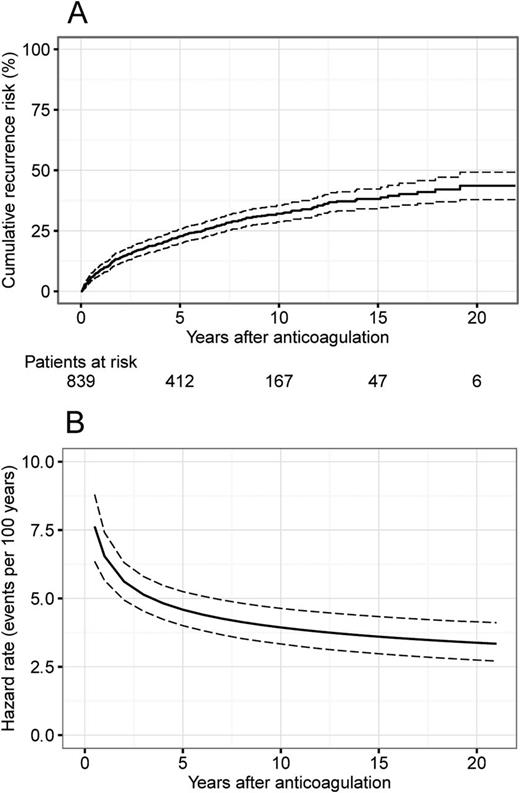Abstract
Background: The long-term recurrence risk (ltRR) of venous thromboembolism (VTE) and its determinants are uncertain. We set out to assess the long-term RR of VTE in a homogenous cohort with first symptomatic unprovoked deep-vein thrombosis (DVT) of the leg or symptomatic pulmonary embolism (PE).
Methods: Between July 1992 and September 2008, consecutive patients older than 18 years with a first unprovoked symptomatic DVT of the leg or PE were included after withdrawal of anticoagulation. Patients were excluded if they had VTE associated with a temporary risk factor, major thrombophilia, or if they received long-term antithrombotic treatment for other reasons. Diagnosis of VTE was established by compression ultrasonography, venography, spiral computed tomography, or lung scanning. End point of the study was objectively confirmed symptomatic recurrent VTE. The absolute ltRR was estimated by the cause-specific cumulative incidence method, considering death and re-initiation of antithrombotic treatment as competing events. By taking years of follow-up as the time scale and multiplying by 100, hazard rates can be interpreted as events per 100 patient-years. 95% confidence intervals (CI) for the estimated hazard rates were obtained using the bootstrap percentile method based on 1000 resamples of the original observations with replacement. Comparisons between groups were based on cause-specific hazard ratios estimated by univariable and multivariable Cox models.
Results: 839 patients (mean age 53 years) were prospectively followed for a median of 7.7 years (25th percentile 3.3 years, 75th percentile 11.4 years). 263 (31%) had symptomatic recurrence, which was unprovoked in 232 patients (88%) and associated with a temporary risk condition in 31 patients. PE was fatal in 4 patients. The cumulative RR was 9% (95% CI, 7 to 11) after 1 year, 23% (95% CI, 20 to 26) after 5 years, 32% (95% CI, 29 to 36) after 10 years, and 44% (95% CI, 38 to 49) after 20 years (Figure 1, A). The hazard rate of recurrence was 6.5 events per 100 patient-years (95% CI, 5.7 to 7.4) at 1 year, 4.6 (95% CI, 4.0 to 5.2) at 5 years, 3.9 (95% CI, 3.3 to 4.6) at 10 years and 3.3 events per 100 patient-years (95% CI, 2.7 to 4.0) at 20 years (Figure 1, B). The RR among men and women was 39% (95% CI, 35 to 44) and 18% (95% CI, 14 to 23) after 10 years and 51% (95% CI, 44 to 58) and 27% (95% CI, 20 to 34) after 20 years, respectively. The hazard ratio of recurrence for men compared with women was 2.1 (95% CI, 1.6 to 2.9). After 20 years, the RR was 54% (95% CI, 46 to 61) among men with a first unprovoked PE or proximal DVT, 38% (95% CI, 19 to 57) among men with a first unprovoked distal DVT and 29% (95% CI, 21 to 37) among women with a first unprovoked PE or proximal DVT. After 15 years, the RR was 17% (95% CI, 7 to 31) among women with a first unprovoked distal DVT. Compared to women with a first distal DVT, hazard ratios were 2.3, 2.3, and 4.7 for men with a first distal DVT, women with a first PE or proximal deep-vein-thrombosis, and men with a first PE or proximal DVT, respectively.
Conclusion: The ltRR of VTE among patients with a first unprovoked DVT of the leg or PE is excessively high. The ltRR is particularly high in men with a proximal DVT or PE and is lower in men with a distal DVT and in women regardless of the location of the first thrombosis. We propose that sex together with thrombus site should be considered when counseling patients regarding the duration of secondary thromboprophylaxis.
Cumulative risk of recurrence (A) and hazard rate of recurrence (events per 100 patient-years, B).
Cumulative risk of recurrence (A) and hazard rate of recurrence (events per 100 patient-years, B).
No relevant conflicts of interest to declare.
Author notes
Asterisk with author names denotes non-ASH members.


This feature is available to Subscribers Only
Sign In or Create an Account Close Modal